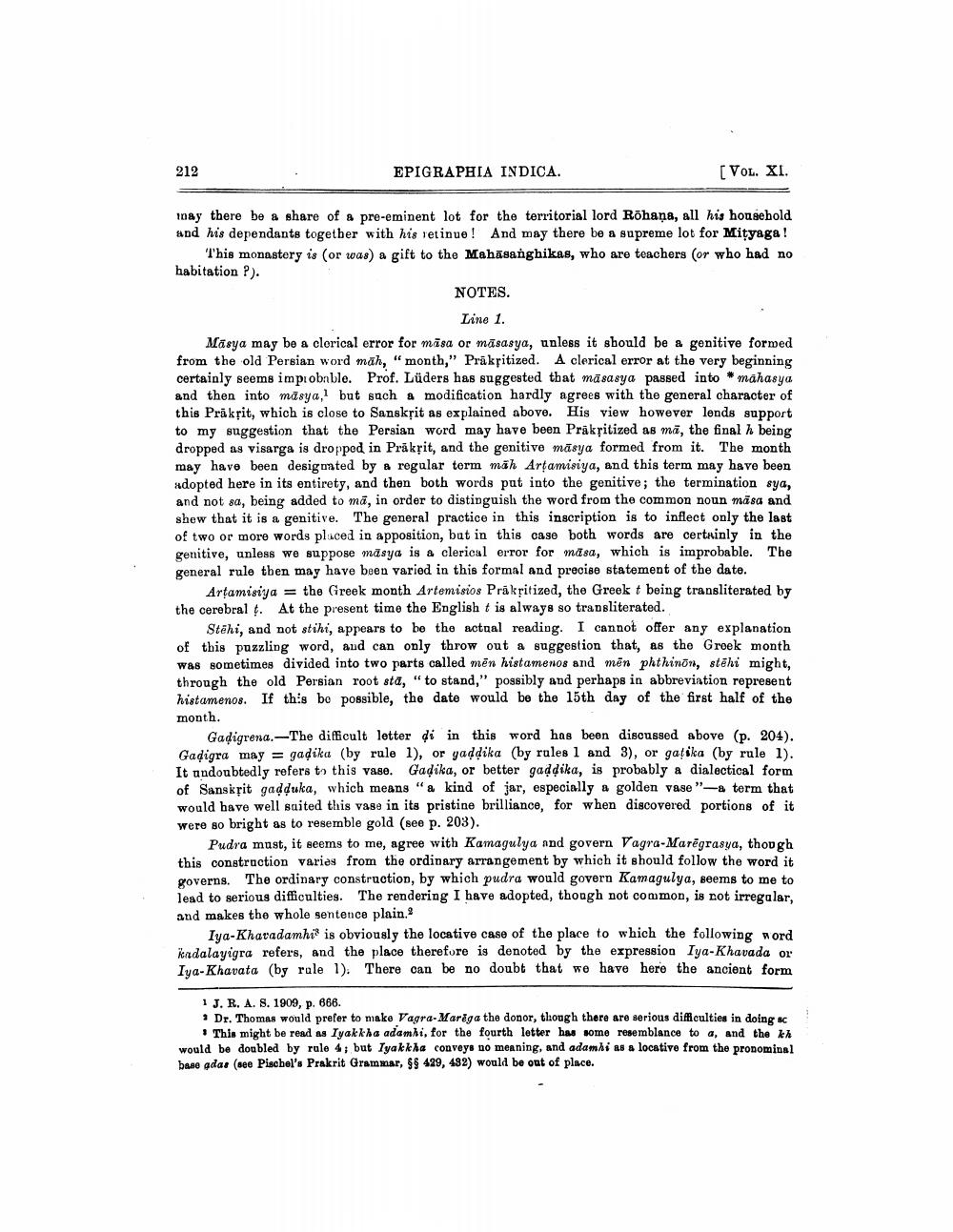________________
212
EPIGRAPHIA INDICA.
VOL. XI.
way there be a share of a pre-eminent lot for the territorial lord Röhana, all his housebold and his dependants together with his retinue ! And may there be a supreme lot for Mityaga !
This monastery is (or was) a gift to the Mahasanghikas, who are teachers (or who had no habitation ?).
NOTES.
Line 1. Masya may be a clorical error for māsa or māsasya, unless it should be a genitive formed from the old Persian word mah, "month," Prākṣitized. A clerical error at the very beginning certainly seems improbable. Prof. Lüders has suggested that māsasya passed into * mahasya and then into māsya, but such a modification hardly agrees with the general character of this Prākṣit, which is close to Sanskļit as explained above. His view however lends support to my suggestion that the Persian word may have been Prakritized as mā, the final h being dropped as visarga is dropped in Prakrit, and the genitive māsya formed from it. The month may have been designated by a regular term mäh Artamisiya, and this term may have been adopted here in its entirety, and then both words put into the genitive; the termination sya, and not sa, being added to mā, in order to distinguish the word from the common noun mäsa and shew that it is a genitive. The general practice in this inscription is to inflect only the last of two or more words placed in apposition, but in this case both words are certainly in the genitive, unless we suppose mäsya is a clerical error for masa, which is improbable. The general rule then may have been varied in this formal and precise statement of the date.
Artamisiya = the Greek month Artemisios Prākritized, the Greek t being transliterated by the cerebral . At the present time the English t is always so transliterated.
Stēhi, and not stihi, appears to be the actgal reading. I cannot offer any explanation of this puzzling word, and can only throw out a suggestion that, as the Groek month Was sometimes divided into two parts called mēn histamenos and mên phthinon, stēhi might, through the old Persian root sta, " to stand," possibly and perhaps in abbreviation represent histamenos. If this bo possible, the date would be the 15th day of the first half of the month.
Gadigrena.-The difficult letter di in this word has been discussed above (p. 204). Gadigra may = gadika (by rule 1), or yaddika (by rules 1 and 3), or gaška (by rule 1). It andoubtedly refers to this vase. Gadika, or better gaddika, is probably a dialectical form of Sanskrit gadduka, which means "a kind of jar, especially a golden vase"-a term that would have well saited this vase in its pristine brilliance, for when discovered portions of it were so bright as to resemble gold (see p. 203).
Pudra must, it seems to me, agree with Kamagulya and govern Vagra-Marēgrasya, though this construction varias from the ordinary arrangement by which it should follow the word it governs. The ordinary construction, by which pudra would govern Kamagulya, seems to me to lead to serious difficulties. The rendering I have adopted, though not common, is not irregalar, and makes the whole sentence plain.
Iya-Khavadamhi is obviously the locative case of the place to which the following word Kadalayigra refers, and the place therefore is denoted by the expression Iya-Khavada or Iya-Khavata (by rale 1). There can be no doubt that we have here the ancient form
1 J. R. A. S. 1909, p. 666.
Dr. Thomas would prefer to make Vagra-Marēga the donor, though there are serious difficulties in doing sc
This might be read as Iyakkha adamhi, for the fourth letter has some resemblance to a, and the kh would be doubled by rule 4 ; but Iyakkha conveys no meaning, and adamhi as a locative from the pronominal baseadas (see Pischel's Prakrit Grammar, $$ 429, 482) would be out of place.




